INTRODUCTION
Globally 85 countries have legislation mandating fortification of wheat flour, including the majority of countries in Latin America and the Caribbean. Countries with wheat flour fortification mandates typically fortify with at least iron and folic acid 1. A recent literature review 2 examining the effectiveness of flour fortification found that anemia was most likely to be reduced if a World Health Organization (WHO) recommended iron compound was used in fortification 3. Overall, reductions in anemia were only observed in one third of the groups studied, and reductions in the prevalence of low ferritin were only consistently observed in women, not children 2. Compared to the number of countries that currently fortify, few effectiveness evaluations were available. The Colombian standard for wheat flour fortification allows mills to choose among three iron fortificants (ferrous fumarate, ferrous sulfate, and reduced iron) 4; the first two are WHO recommended while the third is not 3. If a non-recommended form of iron is used to fortify, positive nutritional effects may not be seen at the national level 2,5,6.
In 1996 Colombia mandated fortification of wheat flour with vitamins B1, B2, B3, B9 (folic acid), and iron, while calcium is optional 4. A clarification released in 2013 explicitly states that all domestically produced and imported foods with wheat flour as the main ingredient must use fortified wheat flour 7. To date, no impact evaluations of the country’s wheat flour fortification program have been conducted. This study examines the relationship between consumption of wheat flour during the wheat flour fortification program in Colombia and low serum ferritin and anemia status, using nationally representative data from 2005.
MATERIALS AND METHODS
The 2005 National Nutrition Situation Survey (ENSIN), was conducted in a subset of the households targeted by the 2005 Demographic and Health Survey (DHS, n=37.211) and included 17,740 households 8,9. The DHS survey used probabilistic sampling to ensure it represented 98 % of the national population 8, and the ENSIN survey was representative at the national, urban/rural, regional, and sub-regional levels, and included people aged 0-64 y. Individuals aged 2-64 y participated in a 24 h dietary recall survey and a subset of those completing the survey had blood samples collected. The household selection process and survey administration methods are described elsewhere 8. Briefly, within an identified household, every person 2-20 y and every 3rd person 21-64 y participated in the 24 h dietary recall; every 4th woman 13-49 y, every other child 5-12 y, and every child 1-4 y gave a blood sample 9.
Study population
Children 2-12 y and non-pregnant women 13-49 y who completed the 24 h dietary recall and for whom hemoglobin, serum ferritin and C-reactive protein (CRP) levels were measured were included (Figure 1). Descriptive statistics were calculated for the entire study population with dietary and biological data to examine the general characteristics of individuals present in the dataset (Table 1).
Does consumption of wheat flour containing foods (WFCF) influence iron status and/or anemia status?
This analysis aimed to examine low serum ferritin and anemia status and their relation to consumption of fortified wheat flour. However, the composition of WFCF, specifically the percent composed of wheat flour, was unavailable. The consumption of WFCF was therefore used as a proxy for wheat flour consumption. All unique foods reported in the dietary recall (n=1027) were grouped into broad food types (n=310) and also classified as either containing (n=32) or not containing wheat flour (n=281). Bienestarina is a food that contains fortified wheat flour 9. It is produced and distributed to recipients of the Family Welfare program in Colombia. Bienestarina was commonly reported in the 24 h recall and was categorized as a WFCF. Some of the broad food groups classified as not containing wheat flour had foods within them that did contain wheat flour; these foods were classified individually as containing wheat flour or not.
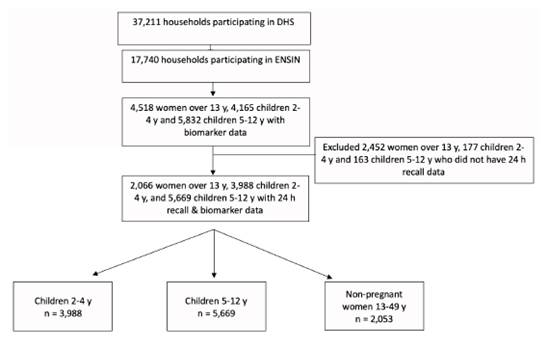
Figure 1 Population flow from Colombia Demographic Health Survey (DHS), through Encuesta Nacional de Situación Nutricional (ENSIN) and included here
Table 1 Overall population characteristics of women and children in the 2005 ENSIN survey weighted for survey
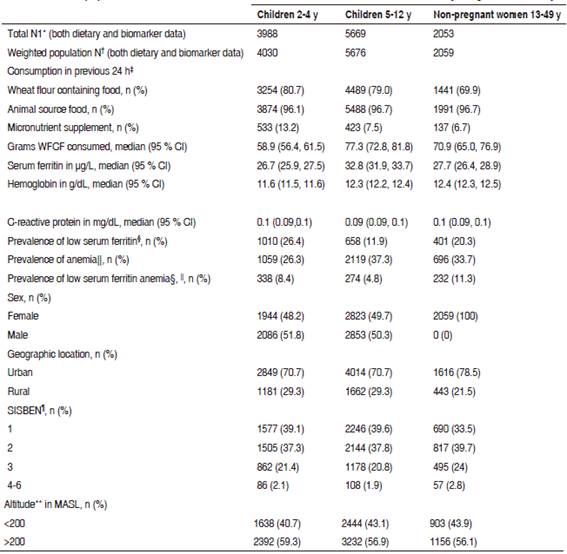
WFCF- Wheat flour containing food
* The total study population had dietary data and both serum ferritin and hemoglobin values. All individuals who had serum ferritin values also had values for C-reactive protein (CRP).
† Weighted analyses were conducted to account for the survey design. All reported counts and percentages in the table are based on the weighted populations.
‡ All consumption was self-reported. Items were categorized as a wheat flour containing food, an animal source food, or micronutrient supplements.
§ Low serum ferritin was defined as having serum ferritin levels <12 μg/L and CRP levels <1.2 mg/dL. All participants with CRP levels ≥1.2 mg/dL were removed from analyses per ENSIN 2005 analytical procedures 8.
|| Anemia was defined as having low hemoglobin levels (<11 g/dL for children 2-4 y and <12 g/dL for children 5-12 y and non-pregnant women 13-49 y), after adjusting for altitude using the Dirren et al. method 11.
¶ An individual’s SISBEN (El Sistema de Selección de Beneficiarios para Programas Sociales) score is a measure of their socioeconomic status, with higher numbers corresponding to higher status 12.
** The Dirren et al. method adjusts hemoglobin for all altitudes > 200 meters above sea level (MASL) 10.
Additionally, some foods were classified as being an animal source food, and micronutrient supplement intake was documented, although the micronutrient formulation was unknown.
Biomarker outcomes were limited to iron status and hemoglobin. Iron is the only nutrient included in the fortification program that was measured in biological samples (serum ferritin). Hemoglobin levels can be influenced by multiple nutrients added to fortified wheat flour: iron, and B-vitamins such as folate, B1, B2, and B3 10. The main outcomes of interest were iron status (as determined through serum ferritin) and anemia status (as determined through altitude-adjusted hemoglobin levels 11.
Laboratory Analyses
Hemoglobin concentrations were determined in real-time via HemoCue, which was calibrated daily and after every 20 measurements 9. All venous samples were processed in the field and frozen in liquid nitrogen until they were sent to the National Health Institute’s Nutritional Laboratory for analysis 9. Plasma ferritin concentrations were measured using the ADVIA Centaur chemiluminescence assay 9. Plasma CRP was measured with a turbidemetric method 9.
Statistical Analyses
Linear regression models were used to estimate the effect of WFCF consumption on biomarker levels as continuous variables (serum ferritin, hemoglobin), and logistic regression models to estimate the effect of WFCF consumption on biomarker levels as categorical variables (low serum ferritin (LSF), anemia). For categorical analyses, biomarker levels were examined as binary outcomes (LSF vs. not LSF). Consistent with how the ENSIN analyzed the biomarker data in 2005 8, individuals were included in low se serum ferritin analyses if their CRP levels were <1.2 mg/dL; individuals were considered to have low serum ferritin if they had eligible CRP levels and their serum ferritin was <12 μg/L. Also consistent with the 2005 ENSIN analyses, hemoglobin levels were adjusted for altitude using the Dirren et al. method 11, and adjusted hemoglobin levels were used in conjunction with age to determine anemia status. Smoking status was unavailable, therefore hemoglobin levels were unable to be adjusted for smoking. Children 2-4 y were considered anemic if their adjusted hemoglobin was <11 g/dL, children 5-12 y and non-pregnant women 13-49 y were considered anemic if their hemoglobin was <12 g/dL. When looking at the effects of WFCF consumption on iron and anemia status, all analyses were conducted within age groups: 2-4 y, 5-12 y and non-pregnant women 13-49 y.
All analyses were conducted in SAS (version 9.3; SAS Institute) using procedures for complex survey design utilizing clusters, strata, and statistical weights to account for differing response rates. All analyses were conducted with and without the weights to see if the outcomes were affected. No differences were found in the outcomes, and therefore weighted counts and models are reported. Methods proposed by Rothman and Greenland 12 were used to adjust all models for confounding. El Sistema de Selección de Beneficiarios para Programas Sociales (SISBEN) level (a measure of socioeconomic status 13, having consumed any animal source food in the previous 24 h, and having consumed any micronutrient supplements in the previous 24 h were included in the final adjusted models.
SISBEN levels were available for every household participating in the ENSIN survey 9. SISBEN scores are assigned to households based on a variety of factors and used to provide the Colombian government with a ranking system to help identify households in need of social welfare programs. Households with scores of 1-2 are in most need, while households with a score of 6 are considered to have the least need 13.
Ethics Considerations
The Instituto Colombiano de Bienestar Familiar (Colombian Institute of Family Wellbeing) and the Instituto Nacional de Salud (INS; National Institute of Health) coordinated the collection and analysis of blood samples; ethical approval was granted by the INS. Written consent was obtained from the adult interviewee or parents of children for the blood draws. The analysis presented here is a secondary analysis of a large, nationally representative dataset. For this analysis, data were provided in a de-identified format; thus, no additional ethical review was sought.
RESULTS
The main characteristics of the women and children from the 2005 ENSIN included in this analysis are summarized in Table 1. The majority of the study population had consumed both WFCF and animal source foods in the previous 24 h. The most commonly consumed WFCF were bread, pasta, cookies, and Bienestarina while the most commonly consumed animals source foods were milk, eggs, and beef. Approximately 13 % of children 2-4 y had taken a supplement in the previous 24 h, while less than 8 % of children 5-12 y and non-pregnant women 13-49 y had taken a supplement (Table 1). Despite being highly prevalent in the population, WFCF consumption varied significantly between socioeconomic strata in all age groups (data not shown, see discussion). The median intake of WFCF ranged from 58.9 g/d in children 2-4 y to 77.3 g/d in children 5-12 y.
Low serum ferritin was prevalent in 26.4 %, 11.9 % and 20.3 % of children 2-4 y, children 5-12 y and non-pregnant women 13-49 y, respectively (Table 1). Anemia was 26.3 %, 37.3 %, and 33.7 % for children 2-4 y, children 5-12 y and non-pregnant women 13-49 y, respectively. The prevalence of low serum ferritin anemia (LSF-A) was <12 % in all age groups. The prevalence of LSF was similar across all levels of WFCF consumption quartiles for all age groups (Figure 2). The highest prevalence of anemia was observed in the lowest WFCF consumption quartiles for all age groups, and the prevalence of anemia was found to be statistically different within age group by quartile of consumption in all age groups except non-pregnant women 13-49 y (Figure 3).
In logistic regression models controlling for SISBEN, having consumed animal source foods and supplements in the previous 24 h, the observed relationship between WFCF and low serum ferritin was statistically significant when comparing quartile 3 vs. 1 in non-pregnant women 13-49 y, but not for any other age group (Table 2). The relationship between WFCF consumption and anemia was statistically significant for children 2-4 y when comparing quartile 2 vs. 1 and quartile 4 vs. 1, but not for any other age group (Table 3). When serum ferritin and hemoglobin were examined as continuous variables, relationships between hemoglobin and continuous WFCF consumption were statistically significant for all age groups in adjusted models, with increased WFCF consumption associated with increased hemoglobin concentrations. Relationships between serum ferritin and continuous WFCF consumption were not statistically significant for any age group.
DISCUSSION
In Colombia, consuming WFCF was associated with a lower prevalence of anemia in children 2-4 y, with the highest prevalence of anemia being observed in the lowest quartiles of WFCF consumption for this age group.
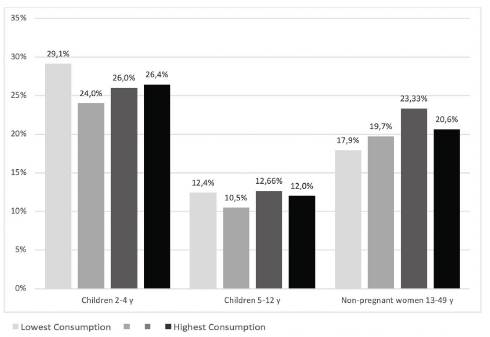
Low serum ferritin was defined as having serum ferritin levels <12 μg/L and CRP levels <1.2 mg/dL. All participants with CRP levels >1.2 mg/dL were removed from analyses per ENSIN 2005 analytical procedures 8. The sample size per group by quartile: Children 2-4 y (975, 997, 1029, and 1029), Children 5-12 y (1382, 1409, 1399, 1485), and Non-pregnant women, 13-49 y (620, 426, 482, 531). Estimated prevalence based on weighted counts for low serum ferritin within each quartile of consumption.
Figure 2 Quartiles of wheat flour containing food consumption, and the unadjusted relationship with low serum ferritin.
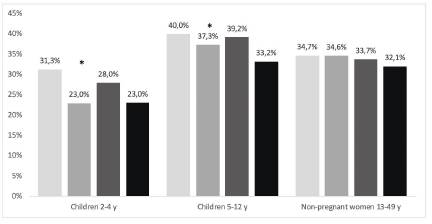
Anemia was defined as having low hemoglobin levels (<11 g/dL for children 2-4 y and <12 g/dL for children 5-12 y and non-pregnant women 13-49 y), after adjusting for altitude using the Dirren et al. method 11. The sample size per group by quartile: Children 2-4 y (975, 997, 1029, and 1029), Children 5-12 y (1382, 1409, 1399, 1485), and Non-pregnant women, 13-49 y (620, 426, 482, 531). Estimated prevalence based on weighted counts for anemia within each quartile of consumption. * Statistically significant; Chi-square p <0.01.
Figure 3 Quartiles of wheat flour containing food consumption, and the unadjusted relationship with anemia.
Table 2 Association between wheat flour containing food (WFCF) consumption and being classified as low serum ferritin

WFCF- Wheat flour containing food
*Low serum ferritin was defined as having serum ferritin levels <12 μg/L and CRP levels <1.2 mg/dL. All participants with CRP levels ≥1.2 mg/dL were removed from analyses per ENSIN 2005 analytical procedures 8.
†Adjusted models controlled for SISBEN level 12, having taken a micronutrient supplement and having consumed an animal source food in previous 24 h.
In this evaluation, we were able to estimate individual intake of WFCF rather than household consumption, but our estimates were limited by our knowledge of the flour content in WFCFs consumed.
For example, foods such as cookies and sandwiches were coded as containing wheat flour, because they were likely made with fortified wheat flour. However, we did not know the proportion of wheat flour in each food, so the entire weight of the cookie/sandwich contributed to the grams of WFCF consumed. We completed analyses for all WFCF and those WFCF where more than 50% of the weight was estimated by us to contain flour; the results did not differ. Additionally, we were unable to calculate iron intake from WFCF. To partially address this, we controlled for consumption of foods known to contain high amounts of iron in all analyses. Knowing the wheat flour composition of all foods consumed and the contributions of each food to total iron intake would allow for a more accurate assessment of the fortified flour exposure.
Despite these limitations, this study is different from other impact evaluation studies because rather than comparing pre/post fortification levels (or changes therein) of low serum ferritin and anemia, 14-16 we looked at individual consumption levels and relationships with health outcomes. Grimm et al. also looked at consumption levels and health outcomes in Oman, but they examined per capita household flour consumption. 17 They found a lower prevalence of iron deficiency in non- pregnant women from households with ≥1 kg of monthly wheat flour consumption compared to women from households with <1 kg per capita consumption per month.
Table 3 Association between wheat flour containing food (WFCF) consumption and being classified as anemic*
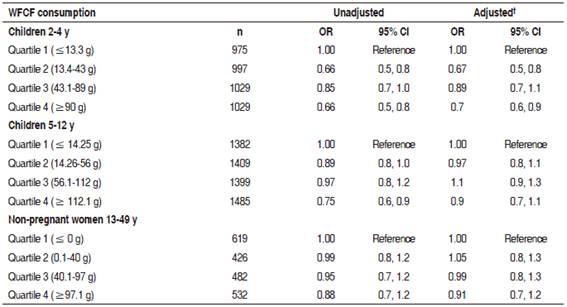
WFCF- Wheat flour containing food
*Anemia was defined as having low hemoglobin levels (<11 g/dL for children 2-4 y and <12 g/dL for children 5-12 y and non-pregnant women 13-49 y), after adjusting for altitude using the Dirren et al. method 11.
†Adjusted models controlled for SISBEN level 12, and having taken a micronutrient supplement and having consumed an animal source food in previous 24 h.
pregnant women from households with ≥1 kg of monthly wheat flour consumption compared to women from households with <1 kg per capita consumption per month.
Other evaluation studies included information on whether the flour was adequately fortified based on government monitoring reports 18 or from sampling and testing flour samples 19-21. In this study, such information was not available for 2005. Regulatory monitoring data from 2011, 2012-13, and 2015 show that 17.5 %, 7.4 % and 7.0 % of flour samples, respectively, did not meet standards (Claudia Patricia Moreno Barrera, Ministerio de Salud y Protección Social, personal communication, 12 September, 2016), suggesting that during the 2011-15 period, most samples met the country’s flour fortification standards. The type and amount of fortificant being used to fortify wheat flour can differ from the country standard; knowing what was used in Colombia would strengthen the analyses reported here. Imported wheat flour products are supposed to be produced with fortified wheat flour, according to the 2013 government clarification 7. In some small stores it was recently noted (anecdotally) that imported WFCF such as pasta were not all labeled as using fortified wheat flour. A better understanding of the compliance of import regulations in Colombia would positively contribute to this evaluation.
In 2009, WHO released recommendations for wheat flour fortification with iron and four other nutrients 3. Colombia was fortifying its flour prior to the release of these recommendations 4. Using non-recommended forms of iron, or less than the recommended amount, may reduce the effectiveness of wheat flour fortification 2,5,6. After Costa Rica changed and intensified the iron component of its food fortification program, researchers found reductions in iron deficiency, anemia and iron-deficiency anemia in children 1-7 y and reductions in anemia in women 14-45 y 18. In 1958 Costa Rica mandated fortification of wheat flour with 45 mg/kg of iron as reduced iron (not a WHO recommended fortificant), but switched in 2002 to 55 mg/kg of iron as ferrous fumarate (a WHO recommended, more bioavailable fortificant).
WHO fortification recommendations are based on wheat flour consumption or availability 3. The median intake for WFCF in Colombia observed in this analysis (58.9-77.3 g/d) puts it in the lowest tier of WHO recommendations (<75 g/d). For this tier, the recommended iron levels for wheat flour are 40 mg/kg as ferric sodium ethylenediaminetetraacetate (NaFeEDTA), 60 mg/kg as ferrous sulfate, or 60 mg/kg as ferrous fumarate. At consumption levels this low, electrolytic iron is not recommended. Currently the Colombia requirement of 44 mg/kg of iron 4 is below the WHO recommendations for ferrous sulfate and ferrous fumarate 3. One of the allowable fortificants in Colombia, reduced iron, is an ineffective fortificant 5. Reduced iron is the least expensive among the three compounds allowed 22, but it is unclear how often it is utilized by flour mills. Increasing the requirement to 60 mg/kg and eliminating the option of using reduced iron, might improve the iron status across the population.
In this study population, low serum ferritin contributed to approximately 1/3 of the anemia in children 2-4 y and non-pregnant women 13-49 y, while contributing to a smaller portion in children 5-12 y (~13 %). The anemia in Colombia may be caused by other nutritional deficiencies as well as non-nutritional causes. Given the limitations with the iron compounds and levels used to fortify wheat flour, it is plausible that the other nutrients in fortified wheat flour (vitamins B1, B2, B3, and B9) are contributing to improvements in hemoglobin synthesis. This could be contributing to the associations between WFCF consumption and hemoglobin in all age groups and between WFCF consumption and anemia in children 2-4 y. In a recent analysis among children in Colombia, micronutrient powders (MNP) were not found to improve hemoglobin status. The authors hypothesize that this could be due to the lower prevalence of iron deficiency anemia 23 which is in line with our observations here.
WFCF consumption differed significantly between certain groups, with urban dwellers and people in higher SISBEN levels more likely to report WFCF consumption. In models looking at WFCF and anemia, WFCF was associated with anemia in 5-12 y children until SISBEN was added (and SISBEN was significantly related to anemia on its own). If accessibility and cost of WFCFs are preventing people in more rural areas and lower SISBEN levels from consuming WFCF, anemia interventions (including the fortification of alternative food products) that target rural populations and lower SISBEN levels may be beneficial.
WHO recommends adjusting women’s hemoglobin data for smoking and lack of these data in this analysis is a limitation 24. Additionally, the current analyses utilized cutoffs for low serum ferritin and anemia that were originally used in the ENSIN report, rather than those recommended by WHO 24,25. This decision was made to remain consistent with reports previously published by the Colombian government. This limits the ability to compare these results to those from other countries that use the WHO cutoffs.
Despite not having information on percent composition of foods, food-specific iron contributions, and fortificants currently in use in Colombia and compliance with standards, this study has several strengths. The sample size is very large and nationally representative of the Colombian popula tion and we were able to control for CRP in the low serum ferritin analyses.
In conclusion, the consumption of WFCF was associated with lower levels of anemia but not low serum ferritin in Colombia, in specific age groups. In adjusted analyses, among children between the ages of 2-4 y, lower anemia prevalence was observed among groups with a higher consumption of wheat flour containing foods. This analysis utilized a large, nationally representative sample with biomarker and food recall data collected in close time proximity. Information on iron fortificants used in Colombia, fortification compliance in the country, and percent composition of wheat flour containing food could strengthen further evaluations of Colombia’s wheat flour fortification program.














